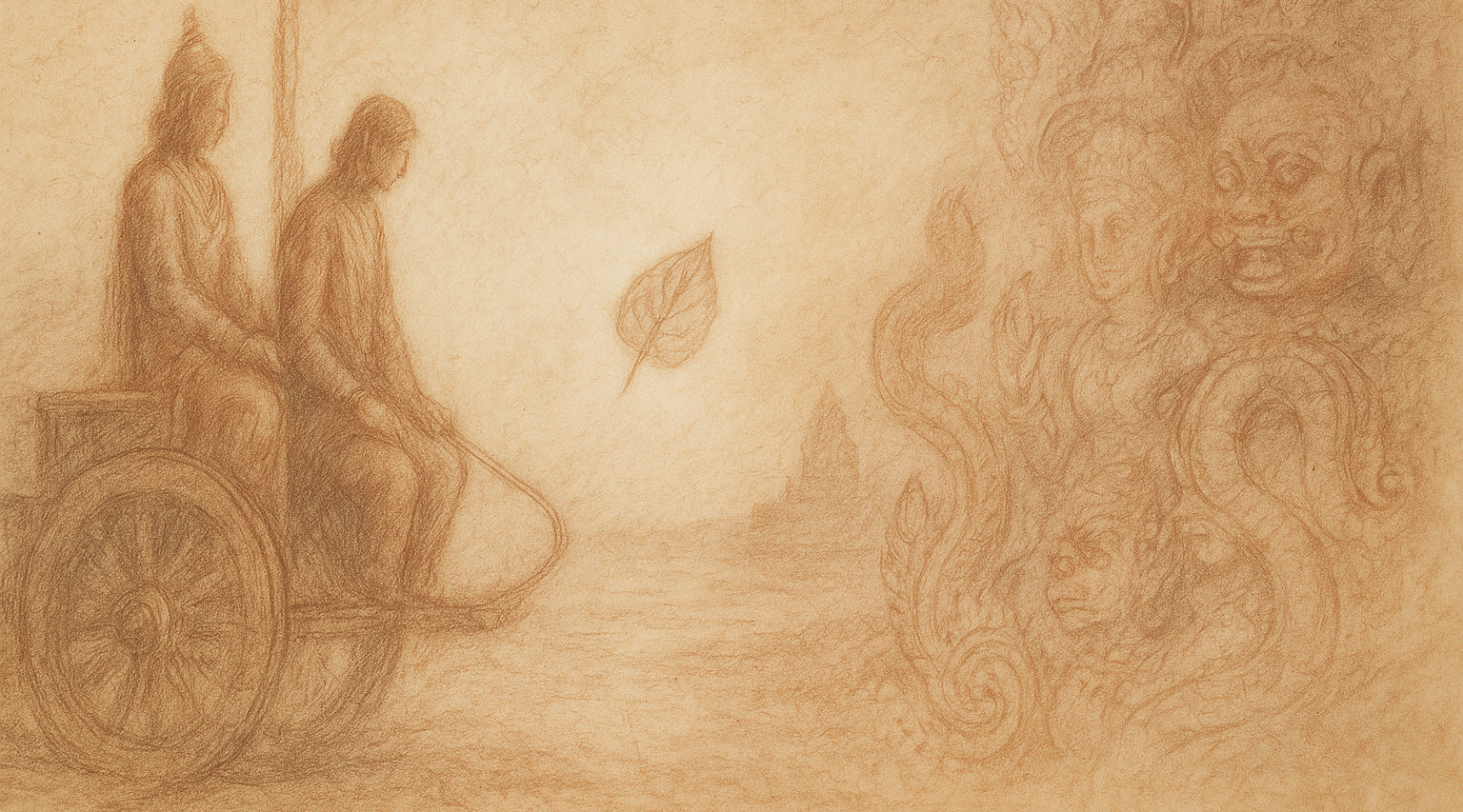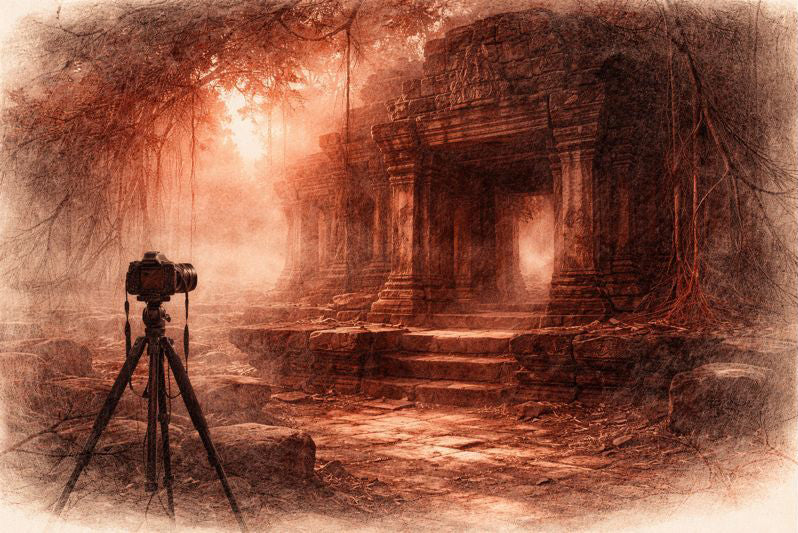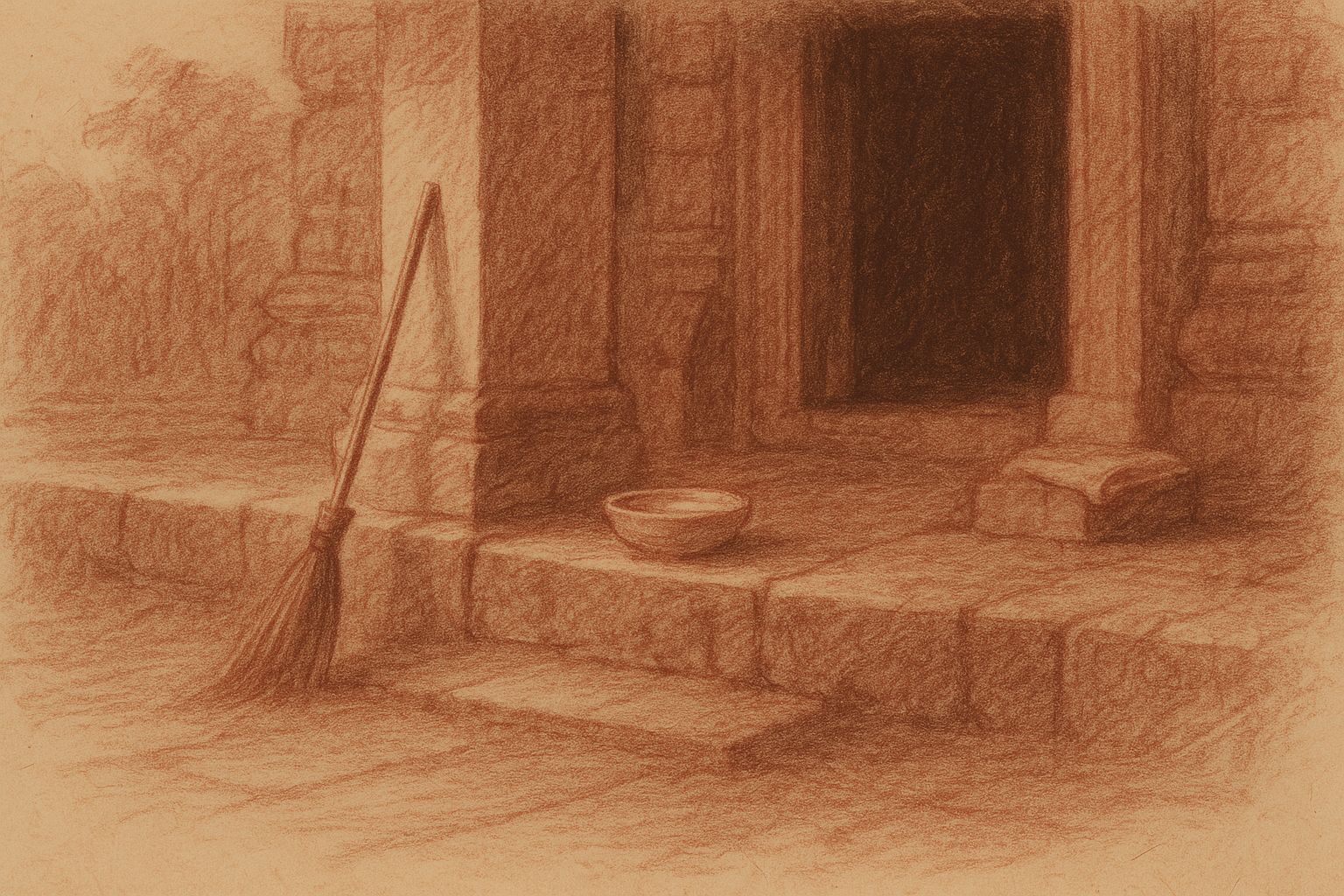Complimentary worldwide shipping on orders over $400 · No import tariffs for most countries
Complimentary worldwide shipping on orders over $400 · No import tariffs for most countries

The Sacred Art of Abridgement: Khmer Myths in Stone
4 min read
What we remember becomes who we are.
And what we carve into stone becomes what we worship.
There is a hush between the carvings at Angkor—a quiet intelligence that does not speak in full stories, but in fragments shaped by memory, faith, and flame. The great epics of India—vast, unwieldy rivers of mythology—did not arrive in Cambodia whole. They came as sacred sparks, dismembered and reimagined, selected not for chronology but for resonance. The Khmer did not merely adopt the epics—they distilled them. And in this sacred distillation, something wholly new was born.
It is tempting, from the distance of centuries, to imagine that the mythologies carved into Angkor’s galleries were chosen to instruct, to preserve a canon, to align with orthodoxy. But these were not didactic tales—they were invocations. They were woven into stone not to explain, but to sanctify space. As incense rises in curling whorls rather than in straight lines, so too did these narratives coil through the corridors—shaping air, shaping light, shaping the soul.
We begin in India, with the colossal vessels of ancient myth: the Mahābhārata, the Rāmāyaṇa, the Purāṇas—sung, inscribed, and retold over centuries across temples, courts, and forests. In their native lands, these stories contained everything: gods and demons, kings and lovers, law and legend, the inner and the infinite. They were vast enough to encompass the cosmos.
But when they crossed into Khmer imagination, something astonishing occurred.
They were not replicated.
They were reborn.
The Khmers did not seek to carve the Mahābhārata in its full unfolding. Instead, they chose a single, luminous moment—the Battle of Kurukshetra—and made it eternal. It is as though the entire epic was pressed into the stillness before Arjuna releases his first arrow. Krishna and Arjuna, side by side in a war chariot, became the beating heart of the myth, suspended in time.
Between thunderous lines
the whisper of dharma speaks—
a chariot waits.
Likewise, the Rāmāyaṇa did not arrive bearing its royal court, familial sorrows, or moral dilemmas. What remained were the marvels—the demons and enchantments, the celestial weapons and flying armies, the gods in disguise. At Angkor Wat and Banteay Srei, it became a myth of radiant conflict—light and shadow in eternal embrace.
One may wonder why.
Why did the Khmer artisans favour battle over blessing, thunder over tenderness?
The answer lies not in mere history, but in mythic psychology. To abridge is to interpret. To choose is to reveal. In an age of kingdoms at war, divine battles may have offered solace. To witness gods struggle across temple walls was perhaps to feel one’s own struggle sanctified. Or perhaps the sheer scale of the temples demanded it. A hand raised in peace might vanish on a thirty-meter frieze, but gods locked in cosmic combat would echo across the centuries.
Yet to reduce this choice to royal ego or aesthetic utility is to miss the deeper truth:
The Khmer did not shorten the stories.
They purified them.
What emerges in the bas-reliefs is not fragment, but essence—a distilled invocation of each tale’s sacred breath. The artists understood what many modern minds forget: that one moment, rightly chosen, can reveal the whole.
From the Mahābhārata, they drew the battle.
From the Bhagavad Gītā, the stillness within the battle.
From the Rāmāyaṇa, the marvel.
From the Jātakas, the compassionate deed.
This was not loss.
It was revelation.
To carve only the essence is to trust its radiance.
Consider the Vessantara Jātaka, in which a prince gives away his wealth, his children, and his very body in acts of boundless generosity. In Khmer tradition, it was not abridged, but exalted. The power of dāna—sacred giving—was carved into doorways and lintels, where every step across stone became a passage through renunciation. In a world where nothing could be possessed forever, surrender became sovereignty.
So too with the Bodhisattvas. They were not narrators of doctrine, but gestures of compassion cast in stone. Their forms need no backstory. Their mudrā is their message.
In Cambodia, myth is rarely canonical. The Rāmāyaṇa becomes the Rāmaxāna. The Mahābhārata condenses to Kurukshetra. The stories are not misremembered—they are re-rooted. What scholars sometimes call “decontextualised incidents” are, in truth, sacred glyphs—selected not to explain, but to resonate. A single scene—like a single bell tone—can awaken what a thousand lines cannot.
Like broken relics still warm with presence, these fragments endure not despite their incompleteness, but because of it.
Even the life of the Buddha was tenderly reshaped. Khmer sculptors favoured the quiet acts: a soft renunciation, a silent gaze, a simple walk beneath the Bodhi tree. The point was never to narrate every step—but to reveal the essence through a single turn of the hand, a single downcast eye.
A seated Buddha, worn smooth by centuries of rain, teaches more than sutras ever could.
The Khmer knew that wholeness is not the same as fullness. Narrative completeness was not their goal—sacred presence was. They chose with reverent precision, carving what stirred them, what mirrored their kings, what offered their people a glimpse of cosmic order and personal truth.
Their myths were not vessels of history.
They were mirrors for the soul.
And so we walk the galleries of Angkor today—past silent battles, grieving demons, and unblinking gods—not as readers of scripture, but as pilgrims of distilled meaning. Each carving is not a scene, but a window. Each fragment is an opening.
What was left unsaid is not forgotten.
It is simply waiting—
in the silence between the stones.
Some truths are too vast to be told whole.
So we carve the part that remembers us.
Also in Library

Before the Shutter Falls
3 min read
Before the shutter falls, fear sharpens and doubt measures the cost of waiting. In the quiet hours before dawn, the act of not-yet-beginning becomes a discipline of attention. This essay reflects on patience, restraint, and the quiet mercy that arrives when outcome loosens its hold.

Those Who Keep the Way Open — On the Quiet Guardians of Angkor’s Thresholds
3 min read
Quiet gestures shape the way into Angkor — a swept stone, a refilled bowl, a hand steadying a guardian lion. This essay reflects on the unseen custodians whose daily care keeps the thresholds open, revealing how sacredness endures not through stone alone, but through those who tend its meaning.

Multiplicity and Mercy — The Face Towers of Jayavarman VII
5 min read
A new vision of kingship rises at the Bayon: serene faces turned to every horizon, shaping a world where authority is expressed as care. Moving through the terraces, one enters a field of steady, compassionate presence — a landscape where stone, light, and time teach through quiet attention.
Join My Studio Journal
Receive occasional letters from my studio in Siem Reap—offering a glimpse into my creative process, early access to new fine art prints, field notes from the temples of Angkor, exhibition announcements, and reflections on beauty, impermanence, and the spirit of place.
No noise. No clutter. Just quiet inspiration, delivered gently.
Subscribe and stay connected to the unfolding story.

Join My Studio Journal
Receive occasional letters from my studio in Siem Reap—offering a glimpse into my creative process, early access to new fine art prints, field notes from the temples of Angkor, exhibition announcements, and reflections on beauty, impermanence, and the spirit of place.
No noise. No clutter. Just quiet inspiration, delivered gently.
Subscribe and stay connected to the unfolding story.
